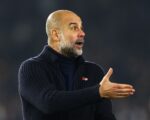Michael Jordan, six-time NBA champion and Naismith Basketball Hall of Fame inductee.
Kiki Rice, the number two overall recruit in the class of 2022 and 2021 SLAM Summer Classic participant.
Rhyne Howard, two-time WNBA All-Star and 2022 WNBA Rookie of the Year.
Jeff Green, one-time NBA champion and 16-year vet.
Those names spring to mind for the public when the Air Jordan 38 gets brought up. The man whose fadeaway inspired the sneaker, the UCLA star that debuted it and two of the pros that have gotten to hoop in it before its worldwide release.
Jacqueline Lefferts, Expert Materials Designer, Performance Footwear at Jordan Brand.
Joël Greenspan, Global Senior Performance Footwear Designer at Jordan Brand.
Chad Troyer, Global Senior Product Line Manager, Performance Footwear at Jordan Brand.
Kris Wright, Global Vice President, Jordan Footwear.
Those names don’t spring to mind when the Air Jordan 38 gets brought up. But they should. That quartet represents some of the leaders on the continent-sprawling, years-encompassing project.
Legendary Nike designer Eric Avar didn’t work on the 38, though he has a famous quote that applies to it.
“Good design is a balance between art and science,” Avar once said.
Lefferts and Greenspan are artists and scientists. They’re meticulous and self-described obsessives and nerds.
“[Lefferts is] very curious, Joël’s very curious,” Troyer tells KICKS about his teammates. “The way they filter performance insights and marry that with their amazing artistic skillset is what really sets our team apart.”
Included in the performance insights for the 38 was the modern hooper’s desire to feel the court. Major throwback to what that six-time champ asked for with the Air Jordan I. That guy wanted to get low to the floor. Jordans would grow to be synonymous with flying through the air. What’s known as the “game shoe” internally at the Brand is known as the main Air Jordan line externally. Historically, most game shoes have been informed by the universal fascination with flight. Everybody wants to go up high in the sky. The 38 is a return to the ground and a revisiting of Mike’s most patented ground-based skill—his fadeaway.
“The thing that we focused on with 38 is separation and MJ’s ability to create separation with one move,” Wright says.
Greenspan and Troyer also confirm that their pitch to His Airness centered on a video showing his fade, Luka Doncic’s fade and Jayson Tatum’s fade. Sneaker technology has improved so much since Mike was hitting fallaways that “a ground game shoe is still possible with great cushioning and propulsion,” Greenspan explains.
The video that the team showed to No. 23 featured an audio clip of His Airness explaining the fadeaway. It was from an instructional video he filmed shortly after the end of his career.
“In shooting a fadeaway, one thing that you try to do is create space between the defense,” Mike said in the video, an echo of what Wright said. “You try as much as possible to square your shoulders up so you’re shooting towards your target. But you also gotta be able to go both ways. That’s a key component in terms of an offensive player, you wanna be able to use all aspects of the shot. That’s another instance of trying to keep the defense off balance so they cannot limit your options. You can make your adjustments shooting the basketball moving away from the target, which is kind of opposite of what you were taught.”
“Opposite” has really always been Mike’s preferred direction, both as a ballplayer and as a sneaker magnate. Through that now-mythical work ethic, he found different paths to walk down during his playing career, paths that he took while wearing his unique footwear. The mindset translate to how Wright approaches his work at the Brand.
“We make informed decisions,” Wright says after sharing that he lives fearlessly in the context of work. “We make informed decisions because we go out and we source the insights and we extrapolate the insights from athletes, from our consumers. Then we’re able to put an objective point of view into the format of a brief and actually get really, really focused on what problems we’re trying to solve for them. We’re constantly and intentionally being disruptive and not being so prescriptive to the point where we can’t surprise and delight consumers.”
Lefferts is also disruptive. Greenspan notes that since Tinker Hatfield stepped aside at Jordan Brand, only the prolific Tate Kuerbis has worked on more game shoes than Lefferts. Simply put, she’s worked on a lot of sneakers for JB.
“Jacqueline has this board of experiments,” Greenspan tells KICKS. “They seem completely unrelated to basketball shoes until you start pulling them down and understanding the properties and there have been more than one moment where, like, a very random swatch from some experiment that Jacqueline’s done long ago finds its way perfectly into a shoe now.”
The 38’s embroidered upper is a product of her mind and her nonstop experimentation.
“Most people think of embroidery as a decorative process, but we realized that we can actually use it to make a material,” Lefferts says. “The embroidery machine can make the component any shape and it also means we can make a material fully from Flightwire. And Flighwire is super, super strong. In, like, every Nike shoe, even from a running shoe or a basketball shoe, if you look inside, you’ll see around the quarter, there’s always Flightwire to give you that harnessing, cinching feeling. For us to have a material entirely made from Flightwire was pretty exciting.”
Lefferts says she’s not actually a Jordan consumer. She thinks that fact works in her favor. Her background as an artist aids her ability to be disruptive and continue to push and push and push.
“I’m always searching for better ways of making, whether it’s with the backless embroidery, where it’s zero waste and making the process better, to evoking some sort of emotion,” she tells KICKS. “I’m super passionate. I want to advance footwear within basketball, but I also, in terms of the emotion it evokes, even from a taste level, I’m always thinking about basketball players, I’m always thinking about Michael.”
Her lasting memory from the 38’s creation process involves Michael.
“We had a moment where the toe was actually different and Joël and I were really set on it,” she says. “We thought it looked amazing. In terms of our theories why it was better than a normal toe, we were like, ‘Our theory is solid. It’s gotta work.’ But MJ was really adamant about switching it so it was just a clean overlay. Which sometimes can feel devastating because you put so much of yourself, so much of your life, like, two years goes into these products. So as a team, we were like, ‘Let’s test both.’ His whole reasoning for wanting to change it was around protecting your toes and not injuring your toes. We tested our option and what MJ said would work better and MJ’s actually did work better.”
This team had two objectives with the 38. One of them was to get back to focusing on MJ as the signature athlete. Check.
“He was definitely more involved in this one than I had ever experienced,” Greenspan says about Mike. “He stepped in a little more heavily on this one.”
The other objective was the aforementioned aspiration to make a lower and more agile pair. To accomplish this, infrastructure of the 38 was the starting point. Greenspan and Troyer knew they wanted to engineer the sneaker around the movements of a fadeaway. They studied the biomechanics of that physical action. Data was compiled on the laterals forces that those extreme turns generate. Players have to be kept on the footbed while performing that intricate footwork. Sliding within an unstable pair was a big concern for the design team. Their research brought them to the innovation of the X-Plate. It also gave them an unexpected way to pay homage to the Air Jordan VIII.
“We were really just trying to push, finding a functional way to tell a story that referenced a really iconic nature of the VIII, but we didn’t want to do a strap on the upper,” Troyer tells KICKS. “That wasn’t how we were trying to get after mobility or the MJ insight around fadeaway. The X-Plate is really underfoot to contain that movement, but it’s really approaching flight in a new way when you see MJ fadeaway.”
The VIII is also referenced in more subtle ways. Lefferts and Greenspan teamed up to use the embroidery as a vehicle to celebrate the ’93 season, the year that Mike wore the VIII to win his third straight chip. They ingrained the embroidery near the collar with 41 crosshatches as a callout to the 41 points per game he averaged in the ’93 Finals.
Cushioning on the 38 is a team effort. A full-length Zoom Strobel sits on top of Cushlon 3.0 that’s housed inside of a slightly firmer foam. Everything is then set in the X-Plate.
Rice, Howard and Green will be among the many following in Mike’s footsteps, creating separation, winning, flying through the air. But they can only do so because of the efforts made by Lefferts, Greenspan, Troyer and Wright, the obsessive and fearless.
“Like Joël said, I’ve worked on a lot of game shoes,” Lefferts, the embroidery expert, says.
“Materials have such an emotional impact, especially in Jordan. If you look at the AJXI, patent leather. It also has to feel, like, instinctively like it’s Jordan, which, to me, this did.”
The post The Air Jordan 38 is Woven Through History by Expert Craftsmanship appeared first on SLAM.





